Text Classification
Text classification is the process of categorizing text documents into predefined categories or labels.
Papers and Code
Hebrew Diacritics Restoration using Visual Representation
Oct 30, 2025Diacritics restoration in Hebrew is a fundamental task for ensuring accurate word pronunciation and disambiguating textual meaning. Despite the language's high degree of ambiguity when unvocalized, recent machine learning approaches have significantly advanced performance on this task. In this work, we present DIVRIT, a novel system for Hebrew diacritization that frames the task as a zero-shot classification problem. Our approach operates at the word level, selecting the most appropriate diacritization pattern for each undiacritized word from a dynamically generated candidate set, conditioned on the surrounding textual context. A key innovation of DIVRIT is its use of a Hebrew Visual Language Model, which processes undiacritized text as an image, allowing diacritic information to be embedded directly within the input's vector representation. Through a comprehensive evaluation across various configurations, we demonstrate that the system effectively performs diacritization without relying on complex, explicit linguistic analysis. Notably, in an ``oracle'' setting where the correct diacritized form is guaranteed to be among the provided candidates, DIVRIT achieves a high level of accuracy. Furthermore, strategic architectural enhancements and optimized training methodologies yield significant improvements in the system's overall generalization capabilities. These findings highlight the promising potential of visual representations for accurate and automated Hebrew diacritization.
Modality Alignment across Trees on Heterogeneous Hyperbolic Manifolds
Oct 31, 2025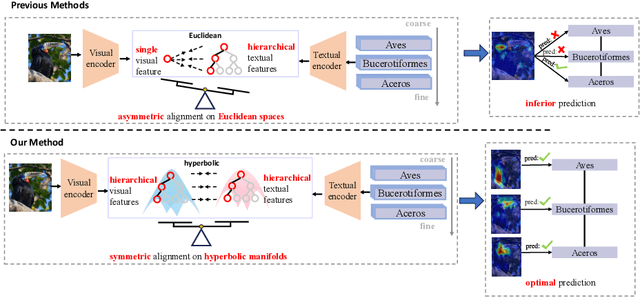
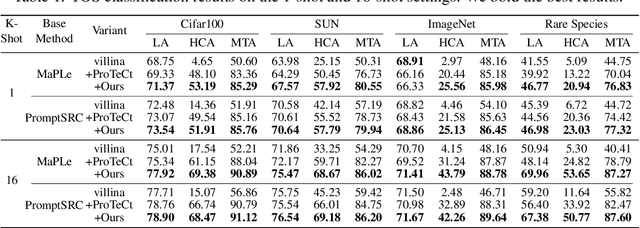
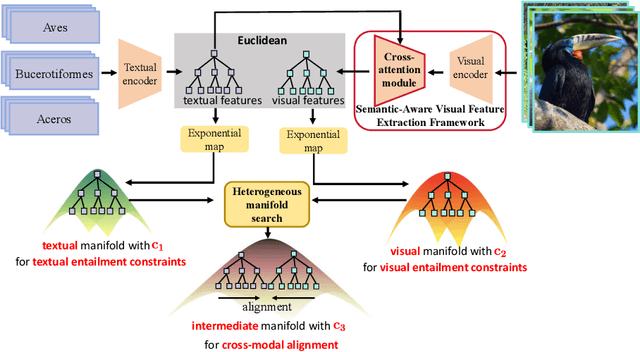

Modality alignment is critical for vision-language models (VLMs) to effectively integrate information across modalities. However, existing methods extract hierarchical features from text while representing each image with a single feature, leading to asymmetric and suboptimal alignment. To address this, we propose Alignment across Trees, a method that constructs and aligns tree-like hierarchical features for both image and text modalities. Specifically, we introduce a semantic-aware visual feature extraction framework that applies a cross-attention mechanism to visual class tokens from intermediate Transformer layers, guided by textual cues to extract visual features with coarse-to-fine semantics. We then embed the feature trees of the two modalities into hyperbolic manifolds with distinct curvatures to effectively model their hierarchical structures. To align across the heterogeneous hyperbolic manifolds with different curvatures, we formulate a KL distance measure between distributions on heterogeneous manifolds, and learn an intermediate manifold for manifold alignment by minimizing the distance. We prove the existence and uniqueness of the optimal intermediate manifold. Experiments on taxonomic open-set classification tasks across multiple image datasets demonstrate that our method consistently outperforms strong baselines under few-shot and cross-domain settings.
ProtoSiTex: Learning Semi-Interpretable Prototypes for Multi-label Text Classification
Oct 14, 2025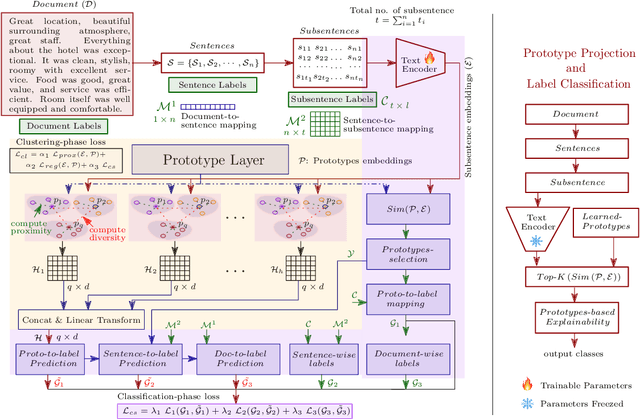
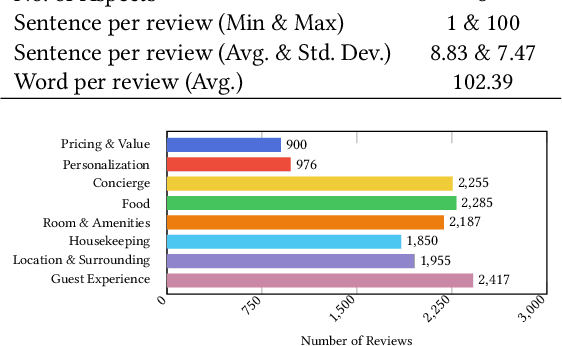


The surge in user-generated reviews has amplified the need for interpretable models that can provide fine-grained insights. Existing prototype-based models offer intuitive explanations but typically operate at coarse granularity (sentence or document level) and fail to address the multi-label nature of real-world text classification. We propose ProtoSiTex, a semi-interpretable framework designed for fine-grained multi-label text classification. ProtoSiTex employs a dual-phase alternating training strategy: an unsupervised prototype discovery phase that learns semantically coherent and diverse prototypes, and a supervised classification phase that maps these prototypes to class labels. A hierarchical loss function enforces consistency across sub-sentence, sentence, and document levels, enhancing interpretability and alignment. Unlike prior approaches, ProtoSiTex captures overlapping and conflicting semantics using adaptive prototypes and multi-head attention. We also introduce a benchmark dataset of hotel reviews annotated at the sub-sentence level with multiple labels. Experiments on this dataset and two public benchmarks (binary and multi-class) show that ProtoSiTex achieves state-of-the-art performance while delivering faithful, human-aligned explanations, establishing it as a robust solution for semi-interpretable multi-label text classification.
AI based signage classification for linguistic landscape studies
Oct 27, 2025Linguistic Landscape (LL) research traditionally relies on manual photography and annotation of public signages to examine distribution of languages in urban space. While such methods yield valuable findings, the process is time-consuming and difficult for large study areas. This study explores the use of AI powered language detection method to automate LL analysis. Using Honolulu Chinatown as a case study, we constructed a georeferenced photo dataset of 1,449 images collected by researchers and applied AI for optical character recognition (OCR) and language classification. We also conducted manual validations for accuracy checking. This model achieved an overall accuracy of 79%. Five recurring types of mislabeling were identified, including distortion, reflection, degraded surface, graffiti, and hallucination. The analysis also reveals that the AI model treats all regions of an image equally, detecting peripheral or background texts that human interpreters typically ignore. Despite these limitations, the results demonstrate the potential of integrating AI-assisted workflows into LL research to reduce such time-consuming processes. However, due to all the limitations and mis-labels, we recognize that AI cannot be fully trusted during this process. This paper encourages a hybrid approach combining AI automation with human validation for a more reliable and efficient workflow.
Interpretable Multimodal Zero-Shot ECG Diagnosis via Structured Clinical Knowledge Alignment
Oct 24, 2025Electrocardiogram (ECG) interpretation is essential for cardiovascular disease diagnosis, but current automated systems often struggle with transparency and generalization to unseen conditions. To address this, we introduce ZETA, a zero-shot multimodal framework designed for interpretable ECG diagnosis aligned with clinical workflows. ZETA uniquely compares ECG signals against structured positive and negative clinical observations, which are curated through an LLM-assisted, expert-validated process, thereby mimicking differential diagnosis. Our approach leverages a pre-trained multimodal model to align ECG and text embeddings without disease-specific fine-tuning. Empirical evaluations demonstrate ZETA's competitive zero-shot classification performance and, importantly, provide qualitative and quantitative evidence of enhanced interpretability, grounding predictions in specific, clinically relevant positive and negative diagnostic features. ZETA underscores the potential of aligning ECG analysis with structured clinical knowledge for building more transparent, generalizable, and trustworthy AI diagnostic systems. We will release the curated observation dataset and code to facilitate future research.
BUSTED at AraGenEval Shared Task: A Comparative Study of Transformer-Based Models for Arabic AI-Generated Text Detection
Oct 23, 2025This paper details our submission to the Ara- GenEval Shared Task on Arabic AI-generated text detection, where our team, BUSTED, se- cured 5th place. We investigated the effec- tiveness of three pre-trained transformer mod- els: AraELECTRA, CAMeLBERT, and XLM- RoBERTa. Our approach involved fine-tuning each model on the provided dataset for a binary classification task. Our findings revealed a sur- prising result: the multilingual XLM-RoBERTa model achieved the highest performance with an F1 score of 0.7701, outperforming the spe- cialized Arabic models. This work underscores the complexities of AI-generated text detection and highlights the strong generalization capa- bilities of multilingual models.
GigaEmbeddings: Efficient Russian Language Embedding Model
Oct 25, 2025We introduce GigaEmbeddings, a novel framework for training high-performance Russian-focused text embeddings through hierarchical instruction tuning of the decoder-only LLM designed specifically for Russian language (GigaChat-3B). Our three-stage pipeline, comprising large-scale contrastive pre-training in web-scale corpora, fine-tuning with hard negatives, and multitask generalization across retrieval, classification, and clustering tasks, addresses key limitations of existing methods by unifying diverse objectives and leveraging synthetic data generation. Architectural innovations include bidirectional attention for contextual modeling, latent attention pooling for robust sequence aggregation, and strategic pruning of 25% of transformer layers to enhance efficiency without compromising performance. Evaluated on the ruMTEB benchmark spanning 23 multilingual tasks, GigaEmbeddings achieves state-of-the-art results (69.1 avg. score), outperforming strong baselines with a larger number of parameters.
CLIN-LLM: A Safety-Constrained Hybrid Framework for Clinical Diagnosis and Treatment Generation
Oct 26, 2025Accurate symptom-to-disease classification and clinically grounded treatment recommendations remain challenging, particularly in heterogeneous patient settings with high diagnostic risk. Existing large language model (LLM)-based systems often lack medical grounding and fail to quantify uncertainty, resulting in unsafe outputs. We propose CLIN-LLM, a safety-constrained hybrid pipeline that integrates multimodal patient encoding, uncertainty-calibrated disease classification, and retrieval-augmented treatment generation. The framework fine-tunes BioBERT on 1,200 clinical cases from the Symptom2Disease dataset and incorporates Focal Loss with Monte Carlo Dropout to enable confidence-aware predictions from free-text symptoms and structured vitals. Low-certainty cases (18%) are automatically flagged for expert review, ensuring human oversight. For treatment generation, CLIN-LLM employs Biomedical Sentence-BERT to retrieve top-k relevant dialogues from the 260,000-sample MedDialog corpus. The retrieved evidence and patient context are fed into a fine-tuned FLAN-T5 model for personalized treatment generation, followed by post-processing with RxNorm for antibiotic stewardship and drug-drug interaction (DDI) screening. CLIN-LLM achieves 98% accuracy and F1 score, outperforming ClinicalBERT by 7.1% (p < 0.001), with 78% top-5 retrieval precision and a clinician-rated validity of 4.2 out of 5. Unsafe antibiotic suggestions are reduced by 67% compared to GPT-5. These results demonstrate CLIN-LLM's robustness, interpretability, and clinical safety alignment. The proposed system provides a deployable, human-in-the-loop decision support framework for resource-limited healthcare environments. Future work includes integrating imaging and lab data, multilingual extensions, and clinical trial validation.
Reasoning for Hierarchical Text Classification: The Case of Patents
Oct 08, 2025Hierarchical text classification (HTC) assigns documents to multiple levels of a pre-defined taxonomy. Automated patent subject classification represents one of the hardest HTC scenarios because of domain knowledge difficulty and a huge number of labels. Prior approaches only output a flat label set, which offers little insight into the reason behind predictions. Therefore, we propose Reasoning for Hierarchical Classification (RHC), a novel framework that reformulates HTC as a step-by-step reasoning task to sequentially deduce hierarchical labels. RHC trains large language models (LLMs) in two stages: a cold-start stage that aligns outputs with chain-of-thought (CoT) reasoning format and a reinforcement learning (RL) stage to enhance multi-step reasoning ability. RHC demonstrates four advantages in our experiments. (1) Effectiveness: RHC surpasses previous baselines and outperforms the supervised fine-tuning counterparts by approximately 3% in accuracy and macro F1. (2) Explainability: RHC produces natural-language justifications before prediction to facilitate human inspection. (3) Scalability: RHC scales favorably with model size with larger gains compared to standard fine-tuning. (4) Applicability: Beyond patents, we further demonstrate that RHC achieves state-of-the-art performance on other widely used HTC benchmarks, which highlights its broad applicability.
ComProScanner: A multi-agent based framework for composition-property structured data extraction from scientific literature
Oct 23, 2025Since the advent of various pre-trained large language models, extracting structured knowledge from scientific text has experienced a revolutionary change compared with traditional machine learning or natural language processing techniques. Despite these advances, accessible automated tools that allow users to construct, validate, and visualise datasets from scientific literature extraction remain scarce. We therefore developed ComProScanner, an autonomous multi-agent platform that facilitates the extraction, validation, classification, and visualisation of machine-readable chemical compositions and properties, integrated with synthesis data from journal articles for comprehensive database creation. We evaluated our framework using 100 journal articles against 10 different LLMs, including both open-source and proprietary models, to extract highly complex compositions associated with ceramic piezoelectric materials and corresponding piezoelectric strain coefficients (d33), motivated by the lack of a large dataset for such materials. DeepSeek-V3-0324 outperformed all models with a significant overall accuracy of 0.82. This framework provides a simple, user-friendly, readily-usable package for extracting highly complex experimental data buried in the literature to build machine learning or deep learning datasets.
 Add to Chrome
Add to Chrome Add to Firefox
Add to Firefox Add to Edge
Add to Edge